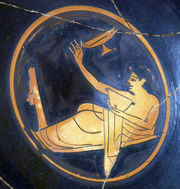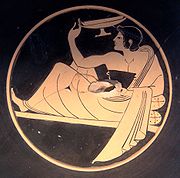
Kottabos
Encyclopedia

Ancient Greece
Ancient Greece is a civilization belonging to a period of Greek history that lasted from the Archaic period of the 8th to 6th centuries BC to the end of antiquity. Immediately following this period was the beginning of the Early Middle Ages and the Byzantine era. Included in Ancient Greece is the...
and Etruscan
Etruscan society
Etruscan society is mainly known through the memorial and achievemental inscriptions on monuments of Etruscan civilization, especially tombs. This information emphasizes family data. Some contractual information is also available from various sources...
symposia (drinking parties)
Symposium
In ancient Greece, the symposium was a drinking party. Literary works that describe or take place at a symposium include two Socratic dialogues, Plato's Symposium and Xenophon's Symposium, as well as a number of Greek poems such as the elegies of Theognis of Megara...
, especially in the 5th and 4th centuries BC. The game is played by flinging wine lees
Lees (fermentation)
Lees refers to deposits of dead yeast or residual yeast and other particles that precipitate, or are carried by the action of "fining", to the bottom of a vat of wine after fermentation and ageing. The yeast deposits in beer brewing are known as trub...
at targets. The player would utter the name of the object of his affection.
The game appears to have been of Sicilian origin, but it spread through Greece from Thessaly
Thessaly
Thessaly is a traditional geographical region and an administrative region of Greece, comprising most of the ancient region of the same name. Before the Greek Dark Ages, Thessaly was known as Aeolia, and appears thus in Homer's Odyssey....
to Rhodes
Rhodes
Rhodes is an island in Greece, located in the eastern Aegean Sea. It is the largest of the Dodecanese islands in terms of both land area and population, with a population of 117,007, and also the island group's historical capital. Administratively the island forms a separate municipality within...
, and was especially fashionable at Athens
Athens
Athens , is the capital and largest city of Greece. Athens dominates the Attica region and is one of the world's oldest cities, as its recorded history spans around 3,400 years. Classical Athens was a powerful city-state...
. Dionysius Chalcus
Dionysius Chalcus
Dionysius Chalcus was an ancient Athenian poet and orator. According to Athenaeus, he was called Chalcus because he advised the Athenians to adopt a brass coinage . His speeches have not survived, but his poems are referred to and quoted by such authors as Plutarch , Aristotle , and Athenaeus...
, Alcaeus
Alcaeus
Alcaeus may refer to:*Alcaeus , a writer of ten plays of the Old Comedy.*Alcaeus , one of several figures of this name in Greek mythology*12607 Alcaeus - a main belt asteroid...
, Anacreon
Anacreon
Anacreon was a Greek lyric poet, notable for his drinking songs and hymns. Later Greeks included him in the canonical list of nine lyric poets.- Life :...
, Pindar
Pindar
Pindar , was an Ancient Greek lyric poet. Of the canonical nine lyric poets of ancient Greece, his work is the best preserved. Quintilian described him as "by far the greatest of the nine lyric poets, in virtue of his inspired magnificence, the beauty of his thoughts and figures, the rich...
, Bacchylides
Bacchylides
Bacchylides was an Ancient Greek lyric poet. Later Greeks included him in the canonical list of nine lyric poets which included his uncle Simonides. The elegance and polished style of his lyrics have been a commonplace of Bacchylidean scholarship since at least Longinus...
, Aeschylus
Aeschylus
Aeschylus was the first of the three ancient Greek tragedians whose work has survived, the others being Sophocles and Euripides, and is often described as the father of tragedy. His name derives from the Greek word aiskhos , meaning "shame"...
, Sophocles
Sophocles
Sophocles is one of three ancient Greek tragedians whose plays have survived. His first plays were written later than those of Aeschylus, and earlier than or contemporary with those of Euripides...
, Euripides
Euripides
Euripides was one of the three great tragedians of classical Athens, the other two being Aeschylus and Sophocles. Some ancient scholars attributed ninety-five plays to him but according to the Suda it was ninety-two at most...
, Aristophanes
Aristophanes
Aristophanes , son of Philippus, of the deme Cydathenaus, was a comic playwright of ancient Athens. Eleven of his forty plays survive virtually complete...
, and Antiphanes
Antiphanes
Antiphanes is regarded as the most important writer of the Middle Attic comedy with the exception of Alexis.He was apparently a foreigner who settled in Athens , where he began to write about 387...
make frequent and familiar allusion to the cottabus – and it appears on vases from the era; but in the writers of the Roman
Roman Empire
The Roman Empire was the post-Republican period of the ancient Roman civilization, characterised by an autocratic form of government and large territorial holdings in Europe and around the Mediterranean....
and Alexandrian period such reference as occurs shows that the fashion had died out. In Latin
Latin
Latin is an Italic language originally spoken in Latium and Ancient Rome. It, along with most European languages, is a descendant of the ancient Proto-Indo-European language. Although it is considered a dead language, a number of scholars and members of the Christian clergy speak it fluently, and...
literature it is almost entirely unknown.
Forms of play

Manes
In ancient Roman religion, the Manes or Di Manes are chthonic deities sometimes thought to represent the souls of deceased loved ones. They were associated with the Lares, Genii, and Di Penates as deities that pertained to domestic, local, and personal cult...
. To be successful the player had to knock off the plastinx in such a way that it would fall to the manes and make a bell like sound. Both the wine thrown and the noise made were called latax (λάταξ). The thrower, in the ordinary form of the game, was expected to retain the recumbent position that was usual at table, and, in flinging the cottabus, to make use of his right hand only.
To succeed in the aim of the game no small amount of dexterity was required, and unusual ability in the game was rated as high as corresponding excellence in throwing the javelin
Pilum
The pilum was a javelin commonly used by the Roman army in ancient times. It was generally about two metres long overall, consisting of an iron shank about 7 mm in diameter and 60 cm long with pyramidal head...
. Not only was the cottabus the ordinary accompaniment of the festal assembly, but, at least in Sicily
Sicily
Sicily is a region of Italy, and is the largest island in the Mediterranean Sea. Along with the surrounding minor islands, it constitutes an autonomous region of Italy, the Regione Autonoma Siciliana Sicily has a rich and unique culture, especially with regard to the arts, music, literature,...
, a special building of a circular form was sometimes erected so that the players might be easily arranged round the basin, and follow each other in rapid succession. Like all games in which the element of chance found a place, it was regarded as more or less ominous of the future success of the players, especially in matters of love – and the excitement was sometimes further augmented by some object of value being staked on the event.
Variations

Cottabus with an oxybaphon
In cottabus with an oxybaphon (Κότταβος δι᾽ ὀξυβάφων), shallow saucers (ὀξύβαφα or "oxybapha") were floated in a basin or mixing-bowl filled with water; the object was to sink each oxybaphon by throwing the wine into it. The competitor who sank the greatest number was considered victorious, and received the prize (κοττάβιον or "cottabium"), which consisted of cakes or sweetmeats.Sunken cottabus
Sunken cottabus (Κότταβος κατακτός) is not so simple. The apparatus (kottabeion, pl. kottabeia) involved consisted of the rhabdus (ῥάβδος, a bronze pole), the plastinx (πλάστιγξ, a small saucer like that on a balance), the lecanis (λεκανίς, a large saucer), and the manes (μάνης, a bronze figurine).The discovery in Etruscan burial sites (by Wolfgang Helbig
Wolfgang Helbig
Wolfgang Helbig was a German classical archaeologist who was a native of Dresden.From 1856 to 1861 he studied philology and archaeology at the Universities of Göttingen and Bonn, and in 1862 became a member of the German Archaeological Institute to Rome...
in 1886) of two sets of actual apparatus in Umbria
Umbria
Umbria is a region of modern central Italy. It is one of the smallest Italian regions and the only peninsular region that is landlocked.Its capital is Perugia.Assisi and Norcia are historical towns associated with St. Francis of Assisi, and St...
, near Perugia
Perugia
Perugia is the capital city of the region of Umbria in central Italy, near the River Tiber, and the capital of the province of Perugia. The city is located about north of Rome. It covers a high hilltop and part of the valleys around the area....
, as well as various representations on Greek vases help explain the somewhat obscure accounts of how cottabus was played.
The rhabdus (pole) had a flat base, and the main structure tapered towards the top, with a blunt end (one which the plastinx or manes was balanced). The plastinx (small saucer) had a hole near the edge and was slightly concave in the middle.
About two-thirds of the way down, the rhabdus was encircled by the lecanis (large saucer). A socket near the top of the rhabdus held the manes (figurine). The manes was in the shape of a man, with his right arm and leg uplifted, sometimes holding a drinking horn (or "rhytum").
According to Helbig, three games were played with this apparatus:
Method No. 1
The plastinx (small saucer) was fixed on top of the rhabdus (pole), with the lecanis (large saucer) below. The players tried to fill the plastinx with enough wine to tip it over (with a crash) onto the lecanis.Method No. 2
Played exactly the same as method No. 1, except that the plastinx was supposed to hit the manes (figurine) on the way down to the lecanis.Method No. 3
Played exactly the same as method No. 1, except that the manes (instead of the plastinx) was fixed on top of the rhabdus, and it was at this that the wine was thrown.External links
- Smith, Dictionary of Greek and Roman Antiquities (pp. 366–367).

